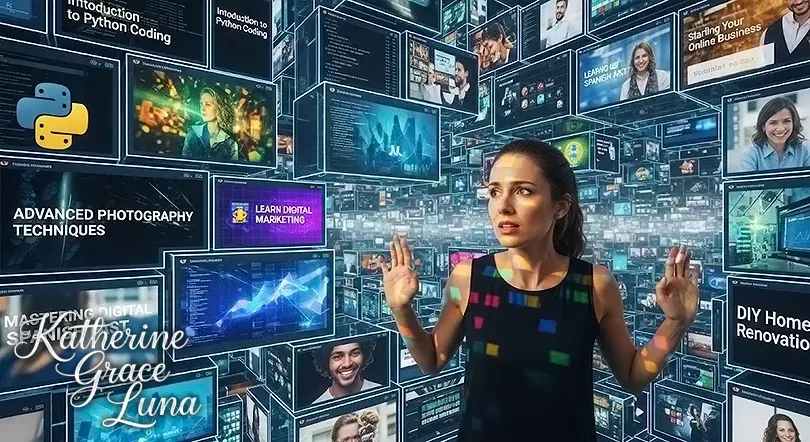Breaking Free from Input Addiction: Why You Can't Stop Learning but Never Start Doing

You've watched 47 YouTube tutorials on web development. Completed three Udemy courses on Python. Downloaded 15 self-help books on productivity. Yet here you are, still unable to build that app you've been dreaming about for months. Sound familiar? Welcome to the modern epidemic of input addiction – where the constant consumption of information has become a sophisticated form of procrastination that feels productive but leads nowhere.

The $45 Billion Problem Nobody Talks About
The global self-improvement industry is expected to grow from $45.7 billion in 2024 to $84 billion by 2034. Yet here's the shocking reality: only 3-15% of people complete the online courses they start. On Udemy, a staggering 70% of buyers never even watch the first video. We're collectively spending billions on courses, tutorials, and books that we'll never finish, trapped in what programmers aptly call "Tutorial Hell."
But this isn't just about wasted money. According to UC Berkeley neuroscientist Ming Hsu's groundbreaking research, information acts on our brain's dopamine-producing reward system in exactly the same way as food, money, or drugs. "To the brain, information is its own reward, above and beyond whether it's useful," Hsu explains. We're literally addicted to learning – but not to doing.
What Tutorial Hell Really Looks Like
In the programming world, Tutorial Hell has become such a recognized phenomenon that it's practically a rite of passage. It's that "metaphysical space where beginner programmers are consigned as punishment for flying too close to the sun of learning," as one developer community puts it. The cycle is painfully predictable:
Step 1: You complete a coding tutorial and learn skill Y.
Step 2: You try building something using skill Y, suddenly realize you need skill X.
Step 3: You find a tutorial for skill X.
Step 4: Rinse and repeat indefinitely.
This isn't limited to coding. Whether you're trying to start a business, learn photography, or improve your fitness, the pattern remains the same. You consume endless content about the thing instead of actually doing the thing.

The Neuroscience of Why You Can't Stop
When Hsu's team at Berkeley scanned people's brains while they played gambling games, they discovered something fascinating. Information about the games activated the exact same brain regions – the striatum and ventromedial prefrontal cortex – that light up for food, money, and drugs. Even more interesting? This happened whether the information was useful or not.
Your brain literally can't tell the difference between valuable information and "empty calories" – just like junk food. That productivity video you're watching for the third time? It's giving you the same dopamine hit as actually completing a project, but without any of the real-world results.
The dopamine system is particularly sensitive to unpredictability. When rewards come randomly – like social media notifications, new tutorial recommendations, or "one more tip" that might be the game-changer – we become even more hooked. This is why you can spend hours jumping from one tutorial to another, always feeling like the next one will finally give you what you need.
The Real Cost of Information Gluttony
Beyond the financial waste (Americans spend an average of $38,000 on self-development over their lifetime), input addiction creates a vicious cycle that actually prevents growth:
Analysis Paralysis: With too much information, decision-making becomes impossible. The University of Chicago found that when too many options overload our short-term memory, performance decreases dramatically. You know so many ways to do something that you can't choose any of them.
Eroded Self-Efficacy: Every tutorial watched without implementation weakens your belief in your ability to execute. Research shows self-efficacy can only be rebuilt through actual performance achievements, not theoretical knowledge. The more you learn without doing, the less capable you feel of doing.
The Perfectionism Trap: Access to endless information creates impossible standards. You always know there's more to learn, another method to try, a better approach to consider. This perfectionism becomes sophisticated procrastination – you're waiting to know everything before you start anything.

Breaking Free: From Consumer to Creator
The solution isn't to stop learning entirely – it's to fundamentally change your relationship with information. Here's how successful creators and builders escape the trap:
1. Implement the 80/20 Learning Rule
Stop trying to learn everything. Focus on the 20% of knowledge that will give you 80% of the results. For most skills, you need far less information than you think to start creating something valuable. A web developer doesn't need to master every framework – they need to build websites. A writer doesn't need to read every book on writing – they need to write.
2. Adopt Just-In-Time Learning
Instead of stockpiling knowledge for "someday," learn only what you need for your current project. This approach has been shown to increase retention rates from 5% (passive learning) to 75% (immediate application). When you hit a roadblock, that's when you search for the specific solution – not before.
3. Build in Public, Not in Preparation
The most effective way to escape Tutorial Hell is to start building immediately and share your progress publicly. This creates accountability and forces you to confront real problems rather than theoretical ones. Your first attempt will be terrible – that's the point. You can't edit a blank page, and you can't improve what doesn't exist.
4. Set "Implementation Intentions"
Research shows that "if-then" planning can double or triple your success rate in achieving goals. Instead of "I'll build something after I learn more," try: "After watching any tutorial, I will immediately spend 30 minutes implementing what I learned." No exceptions.

The MVP Mindset: Your Escape Route
Silicon Valley's Minimum Viable Product (MVP) philosophy isn't just for startups – it's the antidote to input addiction. Instead of trying to build the perfect product after consuming all possible information, you build the simplest possible version that provides value.
For a programmer stuck in Tutorial Hell, this means: stop watching tutorials about building a weather app and build one that just displays the temperature. For an aspiring YouTuber, it means: stop watching videos about YouTube success and upload your first terrible video today.
The goal isn't perfection – it's iteration. Every real-world attempt teaches you more than 100 tutorials because you're forced to solve actual problems, not theoretical ones.
Why "Good Enough" Beats "Perfect" Every Time
The online course industry thrives on our belief that we're just one course away from being ready. But here's what successful creators know: you learn by doing, not by preparing to do. The guitarist who plays badly for audiences improves faster than the one practicing scales alone in their room. The entrepreneur who launches a flawed product learns more than the one still perfecting their business plan.
Studies of online learning platforms that incorporate real project work show dramatically different results. Harvard Business School Online achieved an 85% completion rate by requiring students to apply concepts immediately. Collaborative learning platforms report 91% completion rates when accountability and implementation are built in.

Your Next Step (Not Your Next Tutorial)
If you recognize yourself in this article, here's your challenge: close this tab and spend the next 30 minutes creating something – anything – related to what you've been learning about. Don't watch another tutorial. Don't read another article. Don't wait until you feel ready.
Write 200 words of that blog post. Code one function of that app. Record 30 seconds of that video. Draw one sketch. Send one sales email. Do one pushup. The quality doesn't matter – breaking the consumption cycle does.
Because here's the truth nobody selling courses will tell you: you already know enough. Your problem isn't lack of information – it's lack of implementation. The gap between where you are and where you want to be isn't bridged by consuming more content. It's bridged by creating your own.
The next time you feel the urge to start another tutorial, ask yourself: "Am I learning because I need this specific information right now, or am I learning to avoid doing?" If it's the latter, close the tutorial and open your work. Your future self will thank you.
Remember: every expert was once a disaster. The only difference? They started before they were ready. Now it's your turn.
